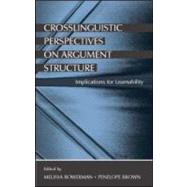
Note: Supplemental materials are not guaranteed with Rental or Used book purchases.
Purchase Benefits
What is included with this book?
| Preface | p. vii |
| Introduction | p. 1 |
| Verb Meaning and Verb Syntax: Crosslinguistic Puzzles for Language Learners | |
| A Person, a Place, or a Thing? Whorfian Consequences of Syntactic Bootstrapping in Mopan Maya | p. 29 |
| The Pitfalls of Getting from Here to There: Bootstrapping the Syntax and Semantics of Motion Event Coding in Yukatek Maya | p. 49 |
| Making Sense of Complex Verbs: On the Semantics and Argument Structure of Closed-Class Verbs and Coverbs in Jaminjung | p. 69 |
| Figure-Ground Indeterminacy in Descriptions of Spatial Relations: A Construction Grammar Account | p. 89 |
| Learning Verbs without Boots and Straps? The Problem of 'Give' in Saliba | p. 111 |
| Participants Present and Absent: Argument Ellipsis and Verb Learning | |
| Same Argument Structure, Different Meanings: Learning 'Put' and 'Look' in Arrernte | p. 141 |
| Verb Specificity and Argument Realization in Tzeltal Child Language | p. 167 |
| Interacting Pragmatic Influences on Children's Argument Realization | p. 191 |
| Transitivity, Entransitivity, and Their Associated Meanings: A Complex Work-Space for Learnability | |
| Intransitive Verbs in Ewe and the Unaccusativity Hypothesis | p. 213 |
| He died old dying to be dead right: Transitivity and Semantic Shifts of 'Die' in Ewe in Crosslinguistic Perspective | p. 231 |
| Acquiring Telicity Crosslinguistically: On the Acquisition of Telicity Entailments Associated with Transitivity | p. 255 |
| The Acquisition of the English Causative Alternation | p. 279 |
| What Adverbs Have to Do with Learning the Meaning of Verbs | p. 309 |
| Event Realization in Tamil | p. 331 |
| Author Index | p. 357 |
| Language Index | p. 363 |
| Subject Index | p. 365 |
| Table of Contents provided by Ingram. All Rights Reserved. |
The New copy of this book will include any supplemental materials advertised. Please check the title of the book to determine if it should include any access cards, study guides, lab manuals, CDs, etc.
The Used, Rental and eBook copies of this book are not guaranteed to include any supplemental materials. Typically, only the book itself is included. This is true even if the title states it includes any access cards, study guides, lab manuals, CDs, etc.